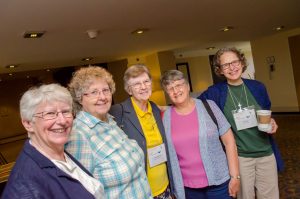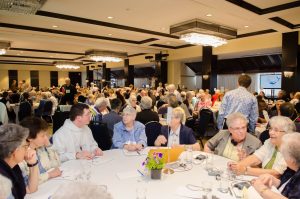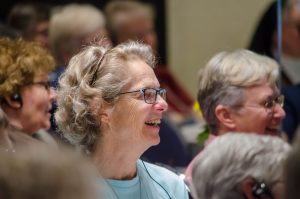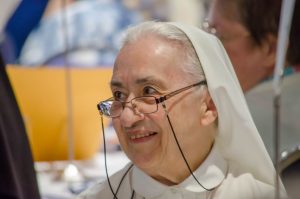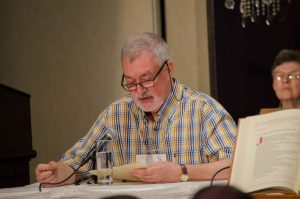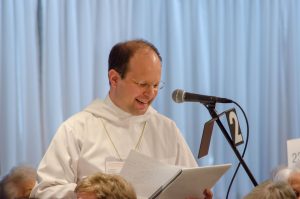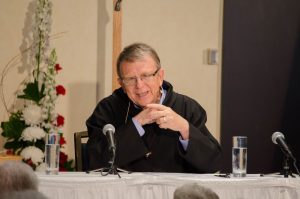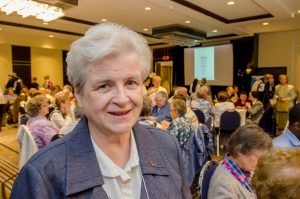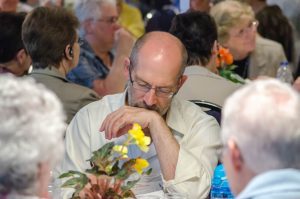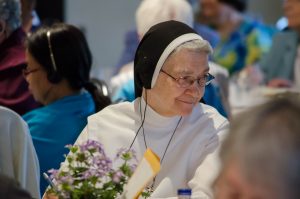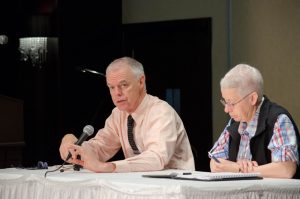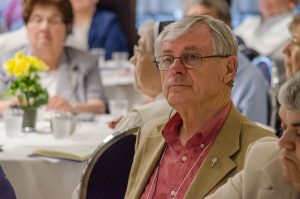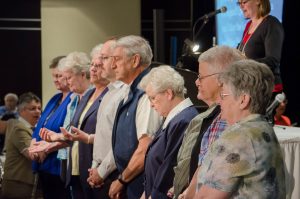The General Assembly of the Canadian Religious Conference has been held from May 26 to 29, 2016 at the Sheraton Montreal Airport Hotel.
The chosen theme of this edition was: The Mission of Congregational Leaders: Amid the Challenges Discerning Hope.
The keynote speaker was Father Simon Pierre Arnold, OSB. A Benedictine Abbot originally from Belgium, Father Arnold has been living for the past 40 years in a monastery he founded in the Peruvian Andes. The author of several books on religious life, his insights and experience has been invaluable for the participants at the General Assembly.
The CRC’s General Assembly is held every two years. The participants are the members of the CRC. It is an opportunity for the leaders of Catholic religious congregations of women and men religious in Canada to meet and share their experience, to reflect on important issues and to celebrate together. At the end of the Assembly, the members will elect a new Administrative Council and propose directions for the next two years.
TV Spot
CWatch below the Salt and Light TV spot realized during the General Assembly of the CRC and broadcasted in the Perspectives TV program.
Daily Summaries
Click on the day of your choice to read the summary
Thursday, May 26
It is before an assembly of 300 women and men religious from across Canada that the 31st General Assembly of the Canadian Religious Conference (CRC) opened. For the first time in 62 years, the opening night began with a welcoming ceremony on Indigenous territory conducted by Thomas Dearhouse, an elder of the Mohawk nation. Thomas Dearhouse continued with the traditional smudging ceremony to clear the mind and spirit of negative energy so as to be renewed and in peace.
The CRC president, Sister Rita Larivée, SSA, declared the Assembly officially opened. In connection with her past experience of working with First Nations, she reminded the CRC members of the importance of working with gratitude. It is in this spirit that she welcomes them at this CRC Assembly. Most Rev. Crosby, president of the Canadian Conference of Catholic Bishops (CCCB) and Most Rev. Lortie, president of the Assemblée des évêques catholiques du Québec (AÉCQ) were invited to say a few words.
Each of them thanked the religious communities of Canada for the work they are accomplishing every day. In connection with the theme of the General Assembly, Most Rev. Crosby spoke of the many challenges the religious communities are facing in particular in a society less opened to the announcement of the Gospel. But he reminded them, “Hope doesn’t disappoint us.” (Rm 5:5) “Hope”, he said, “is a force that draws us forward. Hope is a force most needed when we face difficulties encountered in fulfilling our commitment.” He referred to Pope Francis who invited each one of us to embrace the future with hope.
In the same perspective, Most Rev. Lortie mentioned the fundamental importance of the fidelity in carrying the Church and the needs of the world through prayer. He invited the members to refuse to be marginalized or to be silenced. On the contrary, he asked each consecrated person to be light of the world and to be witness of hope with respect and kindness. Like Jesus who invited the apostles to cast their nets into deep water after having worked all night without catching anything (Luke 5:4), Most Rev. Lortie encouraged the members to act like the apostles and cast their nets into deep water even though they have the impression of not being heard.
Afterwards, Sister Rita Larivée presented the first part of her report to the Assembly going back to the main actions taken by the CRC during the last two years.
A few photos of the first day
Friday, May 27
Conversations that Bear Hope and New CRC Council
On the following day of the opening of the Assembly, two storytellers were invited to share their leadership experience.
Veronica O’Reilly, CSJ, shared some of the difficulties she encountered as congregational leader of the Congregation of the Sisters of St. Joseph in Canada. She spoke of the darkness of her own unknown, of the failure to meet the expectations of others and of the powerlessness of her day to day leadership service. She begged every day for the courage to continue and for the grace of wisdom. She underlined the importance of walking with the sisters, of the capacity for listening and for loving. “She learned so much,” she said, “from the kindness of the sisters, their goodness and the enthusiasm with which they embraced the congregation’s mission.” This kept her going in times of difficulty. At the heart of these challenges she lived and experienced the Paschal Mystery.
Jean-Marc Biron, provincial leader of the French Canada Jesuits and Haiti, shared his story in connection with the Haitian network of 17 schools called “foi et joie” (faith and joy). Established in poor areas by the Jesuits, these schools try to give a good quality education. Unable to find a replacement for the director of this group of schools, Father Biron’s delegate issued a distress call at a meeting of the Jesuits provincials of Latin America without much success. Unexpectedly, Father Marcos Recolons, the superior general’s assistant who was present at that meeting was deeply moved to respond to this call and offered himself to take on this new position. He needed partners to help him in this new mission. Providence led him to facilitate the chapter of the Congregation of the Compagnes de Marie (Companions of Mary), a congregation founded in France and who was present in Haiti in the eighteen century. At his invitation, the sisters decided to take the responsibility of one of the schools in Haiti. Four of them will leave for Haiti this coming September. Father Biron reminded the leaders that it is in our weaknesses that the fire shoots up in our hearts. The same as with the disciples of Emmaus, Jesus continues to walk with us and to be at work through our living out the mission.
Following these two storytellings, the participants were invited to share at their tables and to identify questions they would like the Assembly speaker Simon Pierre Arnold to address in his upcoming talk. Among the points raised are the collaboration with lay people and with other congregations, interculturality, aging of the members of religious congregations and even that of leaders. The members of the assembly also pointed out the importance of ecology, the inclusion of women in the Church, the legacy that women religious can pass on to other generations in a new visionning of the Church.
After lunch, the members elected unanimously the new Administrative Council. Sister Michelle Payette, a Missionary Sister of Mary Immaculate, was elected president.
Following the elections, the General Assembly continued with the talk of the guest speaker Father Simon Pierre Arnold, OSB. He articulated his presentation on the theme of the Assembly in five points:
- A Historical Retrospective of Religious Life in Canada;
- A Subjective Reading of the Present;
- Emerging from Christianity: A Challenge and an Opportunity;
- Towards a “Recreated Religious Life”;
- A New “Ad Gentes” Mission.
We invite you to read the complete text of Father Arnold’s talk by clicking here. CRC’s permission is required prior to copying or publishing this talk:
communications@crc-canada.org.
After the talk the members were invited to share on Father Arnold’s presentation and to note what aspect they would like him to develop further Saturday morning.
The General Assembly is also the opportunity to welcome the Apostolic Nuncio to Canada. Quoting Pope Francis, H.E. Msgr. Bonazzi delivered a message of gratitude and of hope.
The day concluded with the launching of Father Arnold’s most recent book, published in French, “Dieu derrière la porte.”
A few photos of the second day
For more pictures of the General Assembly, visit the CRC Facebook Page by clicking here.
Saturday, May 28
This third day began with a short presentation of Sister Rita Larivée, CRC’s outgoing president. She brought to the members’ attention two resolutions adopted recently by the Administrative Council.
The Administrative Council of the CRC made the decision to sign the CRC’s name to two significant documents prepared by a committee of the CCCB: A Catholic Response to Call to Action # 48 of the Truth and Reconciliation Commission on Adopting and Implementing the United Nations Declaration on the Rights of Indigenous Peoples; The “Doctrine of Discovery” and Terra Nullius: A Catholic Response. Click on this link to the two documents. This was made in solidarity with Development and Peace and the Canadian Conference of Catholic Bishops (CCCB). Sister Rita invited each CRC members to study with their council the section “Walking forward together” with its eight recommendations (page 7 of the document) so as to consider how these eight recommendations might be applied to their own communities. “In this,” she said, “we share a common desire for a renewed relationship with the First Nations of Canada as we go forward together.”
The second resolution concerns the St. Francis Pledge. This is a pledge to pray, act and advocate for ecology and environment. Originating in the United States, the pledge has been adopted by many groups including the LCWR (Leadership Conference of Women Religious) and the CMSM(Conference of Major Superiors of Men). The Administrative Council has adopted this to guide its own practices and the practices of our office in Montreal. Click here to read the St. Francis Pledge. This resolution is presented at the General Assembly for subsequent consideration by the members in their own communities.
Afterwards, members of the CRC Theological Commission presented in a Power Point format the summary of yesterday’s table sharing on challenges. Thy named it “A Pack of Challenges.” These challenges were grouped under 10 headings. They are:
- In Mission Untill the End.
- Religious Life in the World.
- The “inters.”
- Bereavements and New Life.
- Lay Associates.
- Leadership for Tomorrow.
- Change of Mentality.
- From North to South.
- And Vocations?
- Some Practical Questions.
Click here to view the Power Point
Father Simon Pierre Arnold was then invited to speak. In his second talk, he responds to the questions and topics put to him yesterday following his first talk. His presentation is divided into four points: 1. Preliminary Precisions; 2. Religious Life at the Heart of the Tensions of the Kingdom; 3. Evangelization and Decolonization of the Mind (way of thinking); 4. Towards a Religious Life Recreated.
In his preliminary precisions, Father Arnold points out that Jesus in the Gospel responded to questions by a more profound and radical question. The “I do not know” of Jesus in the Gospel makes us responsible. The Gospel is not about how to solve problems but more about shifting them. “We tend”, he said, “to focus on what is not there rather than on recognizing what is already there. The Kingdom of God is already there. That is where true faith is.”
Arnold uses three words to explain his thought on Religious Life at the heart of the tensions of the Kingdom: Already, no more, not yet. We are invited to accept to be a utopia that is to experience what is not already there. “The relationships”, he said, “are to be recreated every day at all levels of life and society. Religious vows need to be thought of in terms of building broken relationships from the stance of our differences. God is difference. God cannot be God without being in a relationship of differences. This is the Trinitarian mystery.”
If evangelization is to create networks of communities where relationships are recreated, then we need to go back to the first evangelization. Religious life began in Alexandria, when a group of rich lay people said no to the Church becoming the right arm of the Empire. This is not the way of being a Christian. They left everything and went to live in the desert. “If Jesus’s celibacy is a denunciation and a renunciation of his patriarchal privilege,” says Arnold, “silence is giving a voice to who does not have it (women and children), the from now on/never again. He inaugurates another society.” Religious life is to live in the margins. What are these margins today?
About the future of religious life, “who said,” comments Arnold, “that religious congregations must be eternal? Only God is eternal. What is important is to transmit how our founders have lived, the passion of the Kingdom.” What matters is to transmit to the future generations the essence of the charism of our congregations so that they can continue to create communities of renewed relationships. Father Arnold points out the need to create spaces for dialogue and for the search of God.
In the afternoon, the participants were invited to reflect and share on two questions: In the course of the last 48 hours, what has nourished and challenged me in my ministry as leader? Based on your own reflection, what mandate do you want to give the new Administrative Council for its ministry over the next two years? A summary of the answers to this question will be presented and discussed at the business meeting on Sunday morning, May 29.
The afternoon ended with the Eucharistic celebration presided by His Eminence Cardinal Lacroix, Archbishop of the Diocese of Quebec and Primate of Canada. The celebration was followed by a festive meal. The evening ended with a performance by Natalie Choquette, a renowned and unique soprano diva. Link to the homily of Cardinal Lacroix in French.
A few photos of the third day
For more pictures of the General Assembly, visit the CRC Facebook Page by clicking here.
Sunday, May 29
On the last day of the 31st General Assembly of the CRC, the outgoing president, Sister Rita Larivée, SSA, and the Executive Director, Father Timothy Scott, CSB, presented their respective reports.
Sister Larivée said a few words on the last part of her report:
- The Theological Commission, namely its role of deepening the meaning of consecrated life and its contribution to the CRC Bulletin.
- The relationships with partners outside the CRC with whom the CRC is building bridges on behalf of the religious of Canada, for example; KAIROS, Development and Peace.
- The necessity to collaborate further with other conferences of women and men religious.
- Keeping good relations with the bishops of Canada and with the Vatican.
- The visit of Vatican’s offices, an opportunity to give a report on the work accomplished by religious communities and on the current situation of the congregations.
Click here to access the President’s report
Similarly, Father Scott presented a overview of the work accomplished by the CRC and its staff. Since the report touches a number of subjects, we are pointing only a few of them: the activities in link with the Year of Consecrated Life, the crisis of Syrian and Afghan refugees, the variety of responses from religious communities to inter-culturality, the JPIC networks, future relations with the First Nations, social justice concerns. Father Scott then spoke about the different services offered by the CRC, the development of CRC communications, the JPIC ongoing work in the regions and about the Donations Priorities Service. Click on this link to view the CRC’s Executive Director’s Report. The Financial report was then presented to the CRC members.
The new CRC President, Sister Michelle Payette, MIC, said a few words to the assembly. “I want to thank Sister Rita Larivée, Father Timothy Scott and the members of the outgoing Administrative Council for their trust. Like Sister Rita, I have never been on the CRC Administrative Council. It will also be for me a baptism of fire…” She adds, “the theme of this gathering stimulates me to take up the challenge of serving as President of the CRC’s Council. […] It is together, humbly, that we move forward so that at the heart of the challenges we may discern hope.”
The discussions that followed were about the financial statements of the CRC and the recommendations by the members to the new Administrative Council. The members of the outgoing Council and of the new Council met afterwards to discuss the directions and priorities for the next two years.
A few photos of the fourth day
For more pictures of the General Assembly, visit the CRC Facebook Page by clicking here.
Documents
- President’s report
- Executive Director’s Report
- Conference of Simon Pierre Arnold
- Catholic Response to Call to Action # 48
- St. Francis Pledge
- Most Rev. Crosby Address
- Most Rev. Lortie Address
- Apostolic Nuncio (Most Rev. Luigi Bonazzi) Address
- Homily of Cardinal Lacroix
- Challenges of Communities
- Schedule
- Press release
